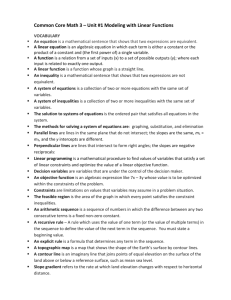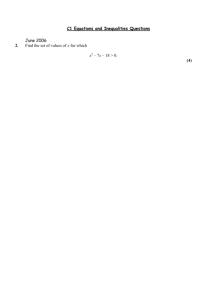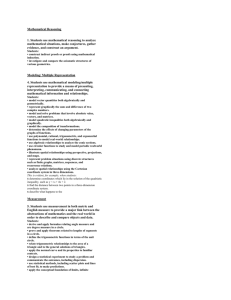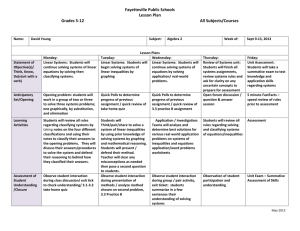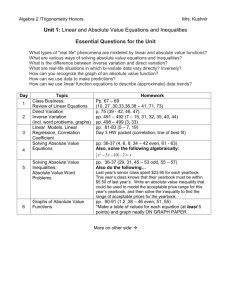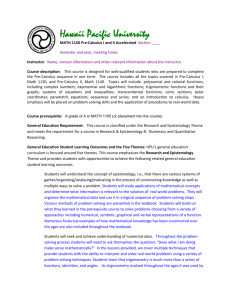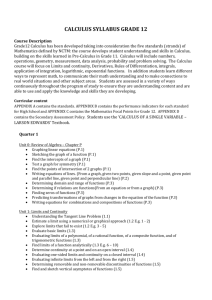Mathematics Class 11 Syllabus
advertisement
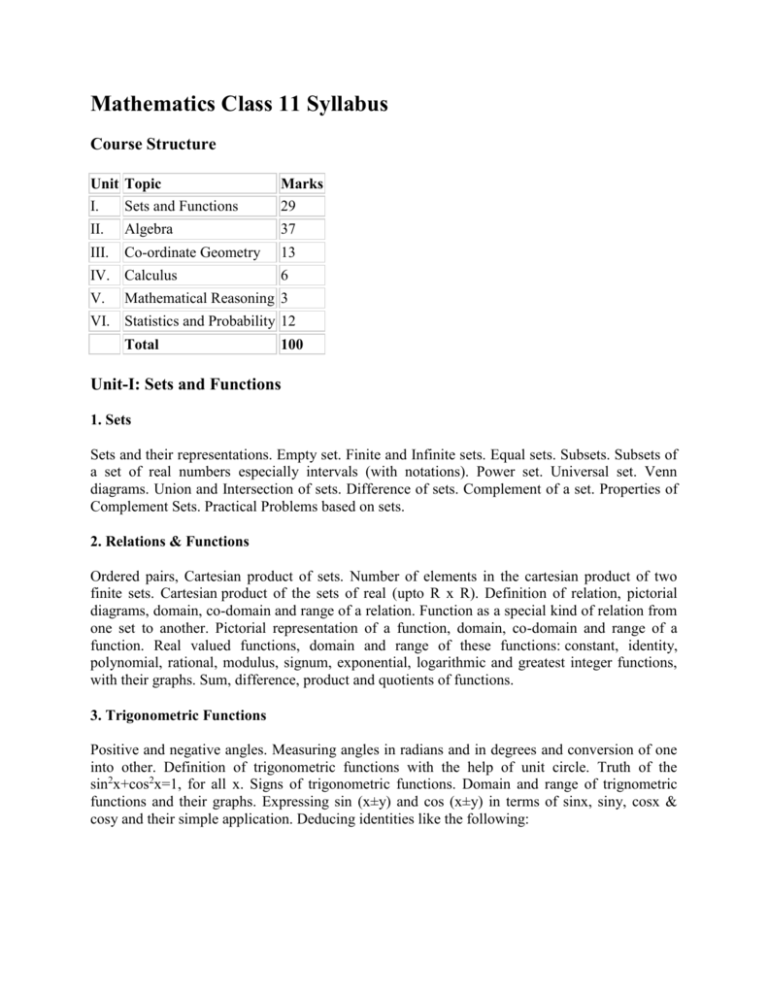
Mathematics Class 11 Syllabus Course Structure Unit Topic Marks I. Sets and Functions 29 II. Algebra 37 III. Co-ordinate Geometry 13 IV. Calculus V. 6 Mathematical Reasoning 3 VI. Statistics and Probability 12 Total 100 Unit-I: Sets and Functions 1. Sets Sets and their representations. Empty set. Finite and Infinite sets. Equal sets. Subsets. Subsets of a set of real numbers especially intervals (with notations). Power set. Universal set. Venn diagrams. Union and Intersection of sets. Difference of sets. Complement of a set. Properties of Complement Sets. Practical Problems based on sets. 2. Relations & Functions Ordered pairs, Cartesian product of sets. Number of elements in the cartesian product of two finite sets. Cartesian product of the sets of real (upto R x R). Definition of relation, pictorial diagrams, domain, co-domain and range of a relation. Function as a special kind of relation from one set to another. Pictorial representation of a function, domain, co-domain and range of a function. Real valued functions, domain and range of these functions: constant, identity, polynomial, rational, modulus, signum, exponential, logarithmic and greatest integer functions, with their graphs. Sum, difference, product and quotients of functions. 3. Trigonometric Functions Positive and negative angles. Measuring angles in radians and in degrees and conversion of one into other. Definition of trigonometric functions with the help of unit circle. Truth of the sin2x+cos2x=1, for all x. Signs of trigonometric functions. Domain and range of trignometric functions and their graphs. Expressing sin (x±y) and cos (x±y) in terms of sinx, siny, cosx & cosy and their simple application. Deducing identities like the following: Identities related to sin 2x, cos2x, tan 2x, sin3x, cos3x and tan3x. General solution of trigonometric equations of the type sin y = sin a, cos y = cos a and tan y = tan a. Unit-II: Algebra 1. Principle of Mathematical Induction Process of the proof by induction, motivating the application of the method by looking at natural numbers as the least inductive subset of real numbers. The principle of mathematical induction and simple applications. 2. Complex Numbers and Quadratic Equations Need for complex numbers, especially √1, to be motivated by inability to solve some of the quardratic equations. Algebraic properties of complex numbers. Argand plane and polar representation of complex numbers. Statement of Fundamental Theorem of Algebra, solution of quadratic equations in the complex number system. Square root of a complex number. 3. Linear Inequalities Linear inequalities. Algebraic solutions of linear inequalities in one variable and their representation on the number line. Graphical solution of linear inequalities in two variables. Graphical solution of system of linear inequalities in two variables. 4. Permutations and Combinations Fundamental principle of counting. Factorial n. (n!)Permutations and combinations, derivation of formulae and their connections, simple applications. 5. Binomial Theorem History, statement and proof of the binomial theorem for positive integral indices. Pascal's triangle, General and middle term in binomial expansion, simple applications. 6. Sequence and Series Sequence and Series. Arithmetic Progression (A.P.). Arithmetic Mean (A.M.) Geometric Progression (G.P.), general term of a G.P., sum of n terms of a G.P., Arithmetic and Geometric series infinite G.P. and its sum, geometric mean (G.M.), relation between A.M. and G.M. Formula for the following special sum: Unit-III: Coordinate Geometry 1. Straight Lines Brief recall of two dimensional geometry from earlier classes. Shifting of origin. Slope of a line and angle between two lines. Various forms of equations of a line: parallel to axis, point-slope form, slope-intercept form, two-point form, intercept form and normal form. General equation of a line. Equation of family of lines passing through the point of intersection of two lines. Distance of a point from a line. 2. Conic Sections Sections of a cone: circles, ellipse, parabola, hyperbola; a point, a straight line and a pair of intersecting lines as a degenerated case of a conic section. Standard equations and simple properties of parabola, ellipse and hyperbola. Standard equation of a circle. 3. Introduction to Three–dimensional Geometry Coordinate axes and coordinate planes in three dimensions. Coordinates of a point. Distance between two points and section formula. Unit-IV: Calculus 1. Limits and Derivatives Derivative introduced as rate of change both as that of distance function and geometrically. Intutive idea of limit. Limits of polynomials and rational functions, trignometric, exponential and logarithmic functions. Definition of derivative, relate it to slope of tangent of a curve, derivative of sum, difference, product and quotient of functions. The derivative of polynomial and trignometric functions. Unit-V: Mathematical Reasoning 1. Mathematical Reasoning Mathematically acceptable statements. Connecting words/ phrases - consolidating the understanding of "if and only if (necessary and sufficient) condition", "implies", "and/or", "implied by", "and", "or", "there exists" and their use through variety of examples related to real life and Mathematics. Validating the statements involving the connecting words difference between contradiction, converse and contrapositive. Unit-VI: Statistics and Probability 1. Statistics Measures of dispersion; Range, mean deviation, variance and standard deviation of ungrouped/grouped data. Analysis of frequency distributions with equal means but different variances. 2. Probability Random experiments; outcomes, sample spaces (set representation). Events; occurrence of events, 'not', 'and' and 'or' events, exhaustive events, mutually exclusive events, Axiomatic (set theoretic) probability, connections with the theories of earlier classes. Probability of an event, probability of 'not', 'and' and 'or' events.

